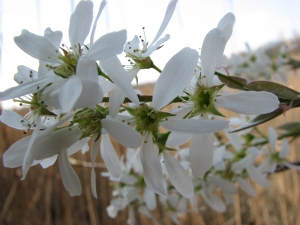Amelanchier arborea
 |
Photo courtesy Renee Brecht |
| Botanical name: | Amelanchier arborea (Michx. f.) Fernald |
| Common name: | common serviceberry, shadbush |
| Group: | dicot |
| Family: | Rosaceae |
| Growth type: | tree/shrub |
| Duration: | perennial |
| Origin: | native |
| Plant height: | 15 - 25' |
| Foliage: | deciduous, alternate, simple leaves, glabrous above, pubescent and paler beneath, finely toothed |
| Flower: | white straplike petals, 5 petals, slightly fragrant, 2-4", pendulous elongated clusters, generally before leaves appear. |
| Flowering time: | mid-late April |
| Habitat: | rich, dry and often rocky, limestone ground of woods and shaded edges, slopes |
| Range in New Jersey: | throughtout NJ; less common on the Coastal Plain |
| Heritage ranking, if any: | n/a |
| Distribution: |  |
| Misc. | According to the USDA, at least 40 species of birds eat the fruit of Amelanchier species, including cedar waxwings, cardinals, towhees, mockingbirds, and Baltimore orioles. A. arborea can be distinguished by the pubescent emerging leaves, greenish-yellow buds, and pendulous fruit. hort.net Called "shadbush" to coincide with the beginning of shad fishing. Edible berries (also called juneberries) resemble blueberries in size and color and are used in jams and pies. Recipes for cookies, creme pie and pancakes made with Juneberries here and Juneberry pie |